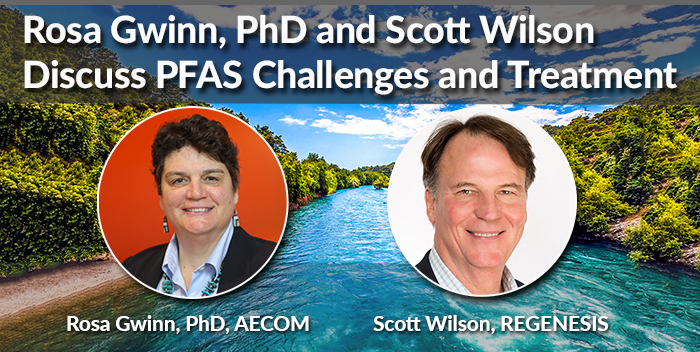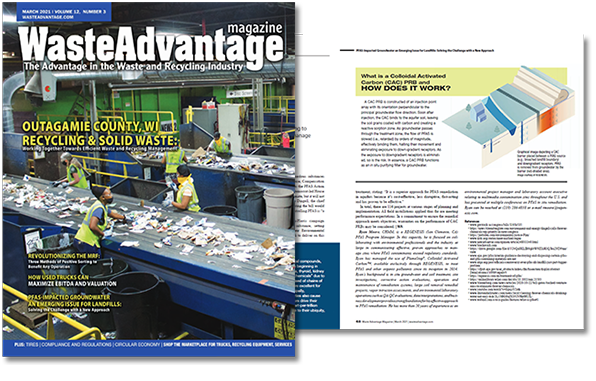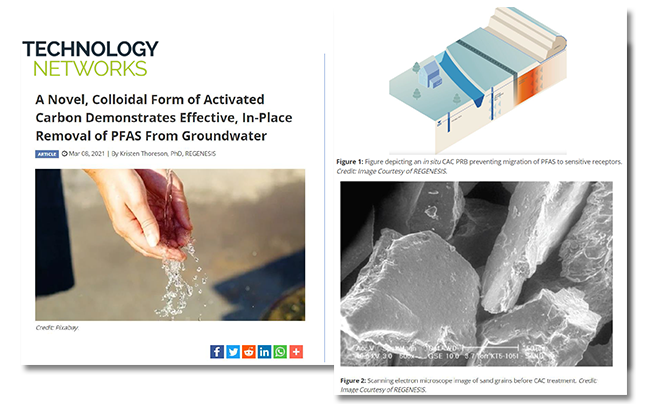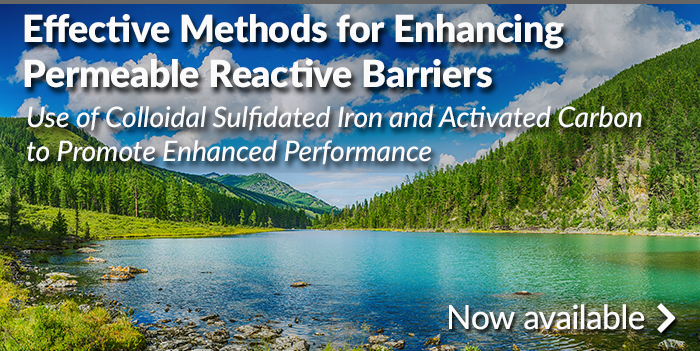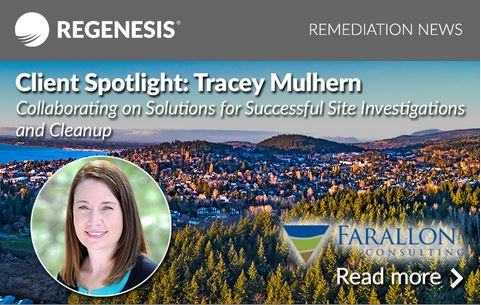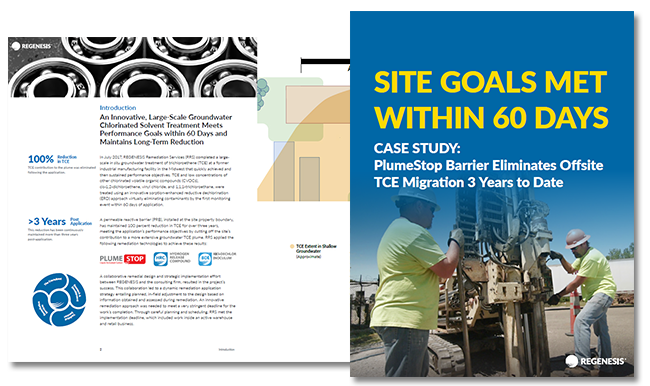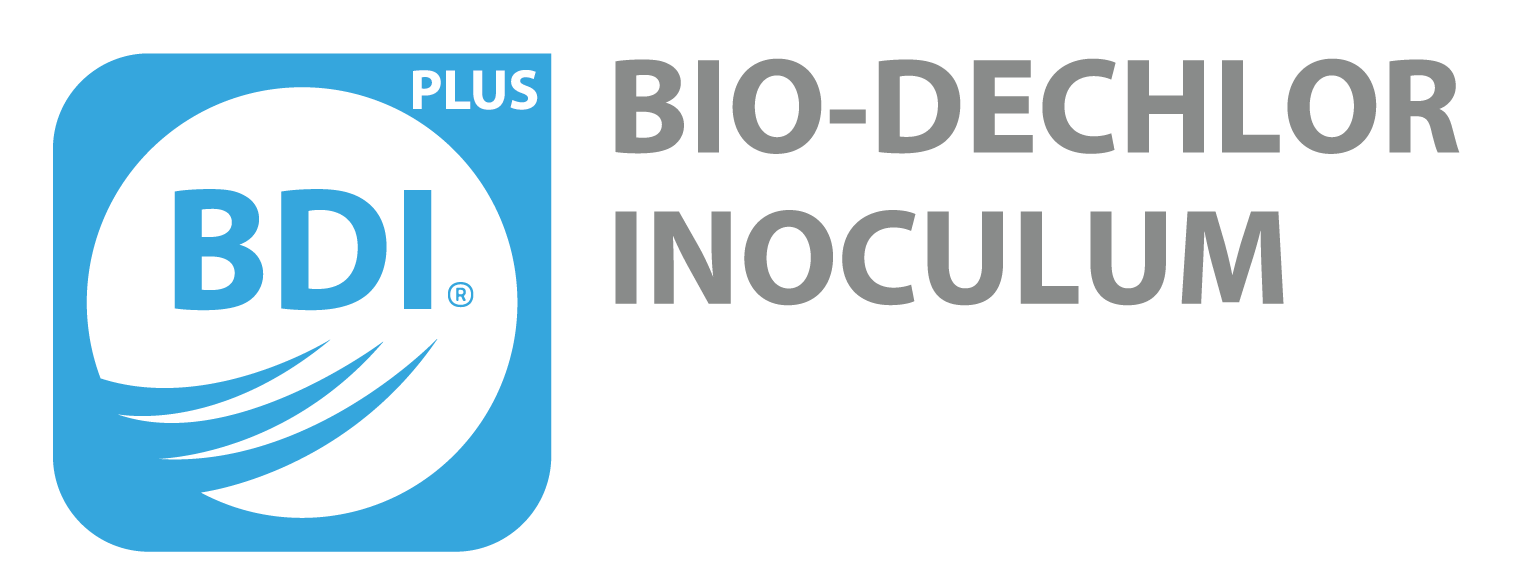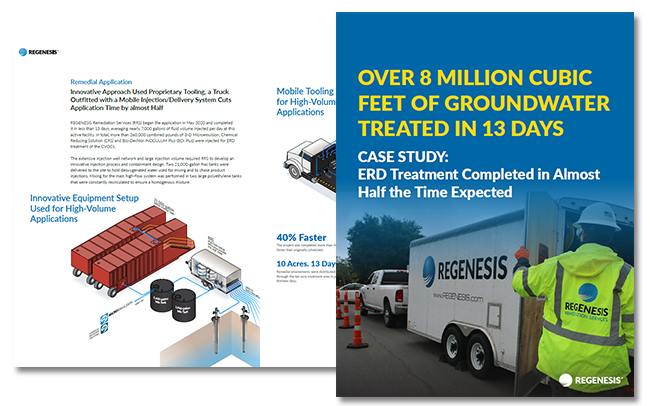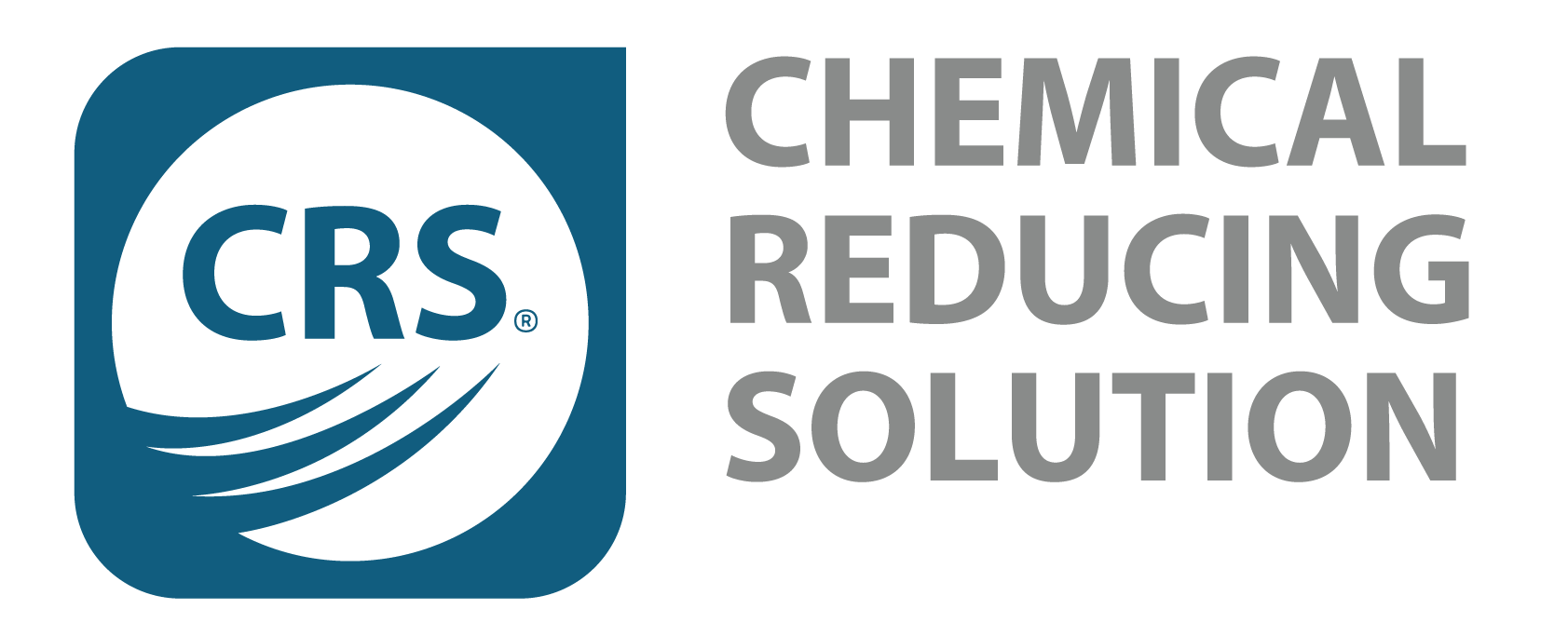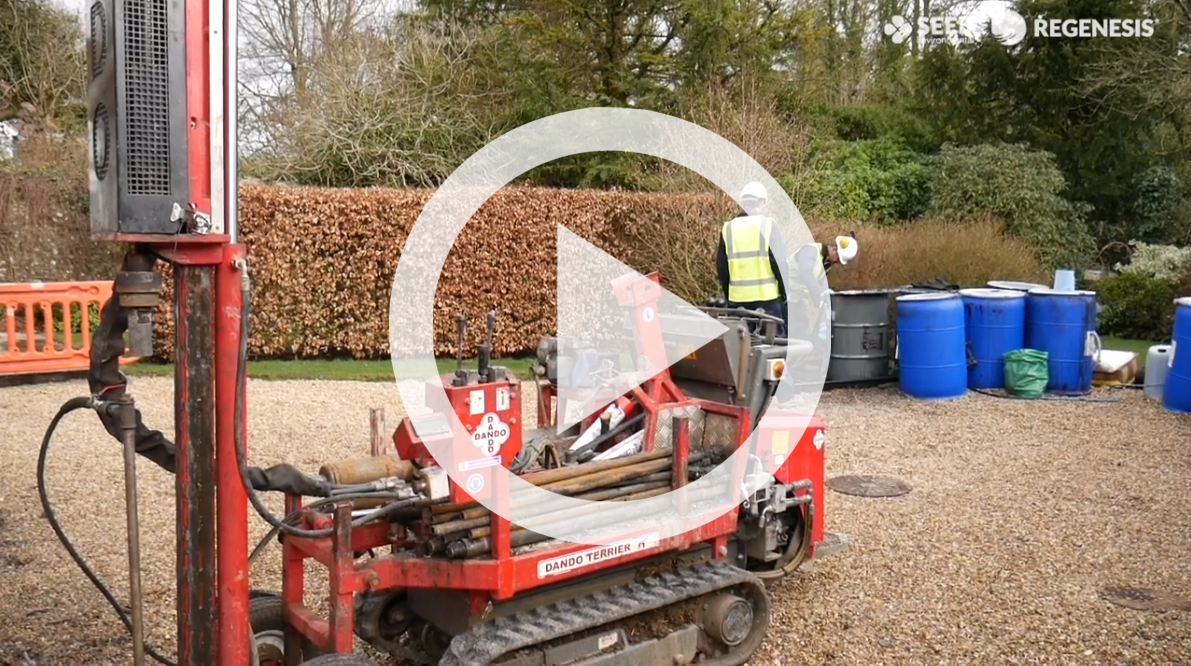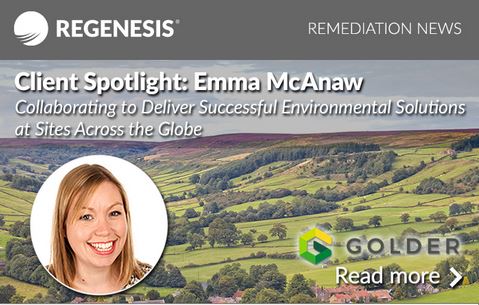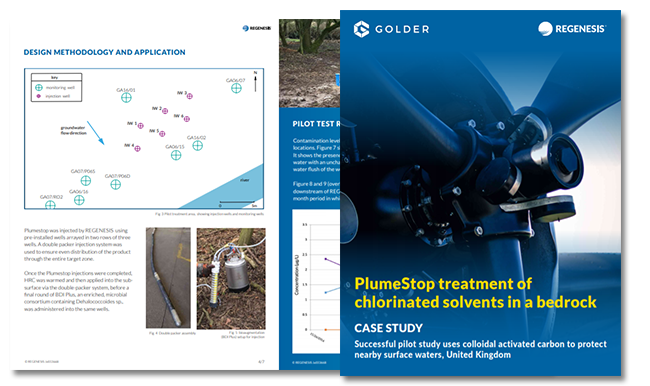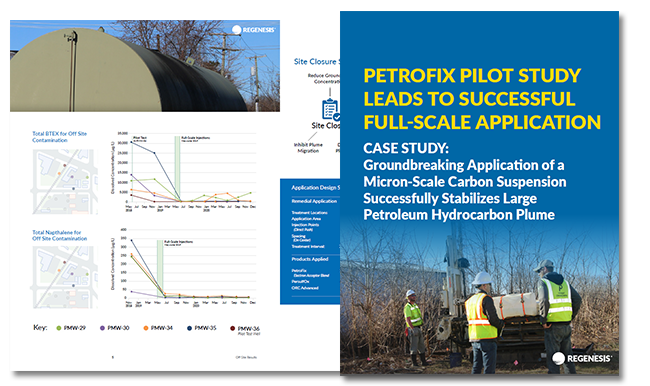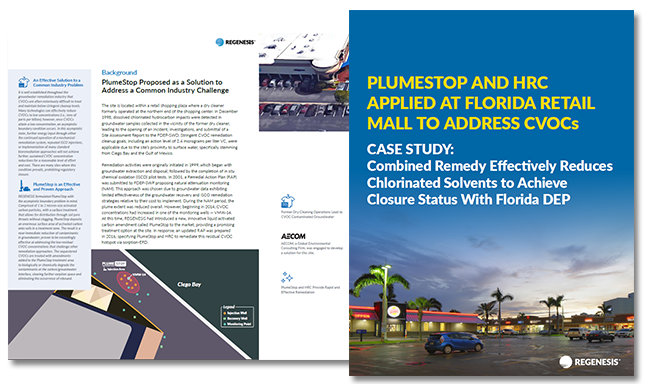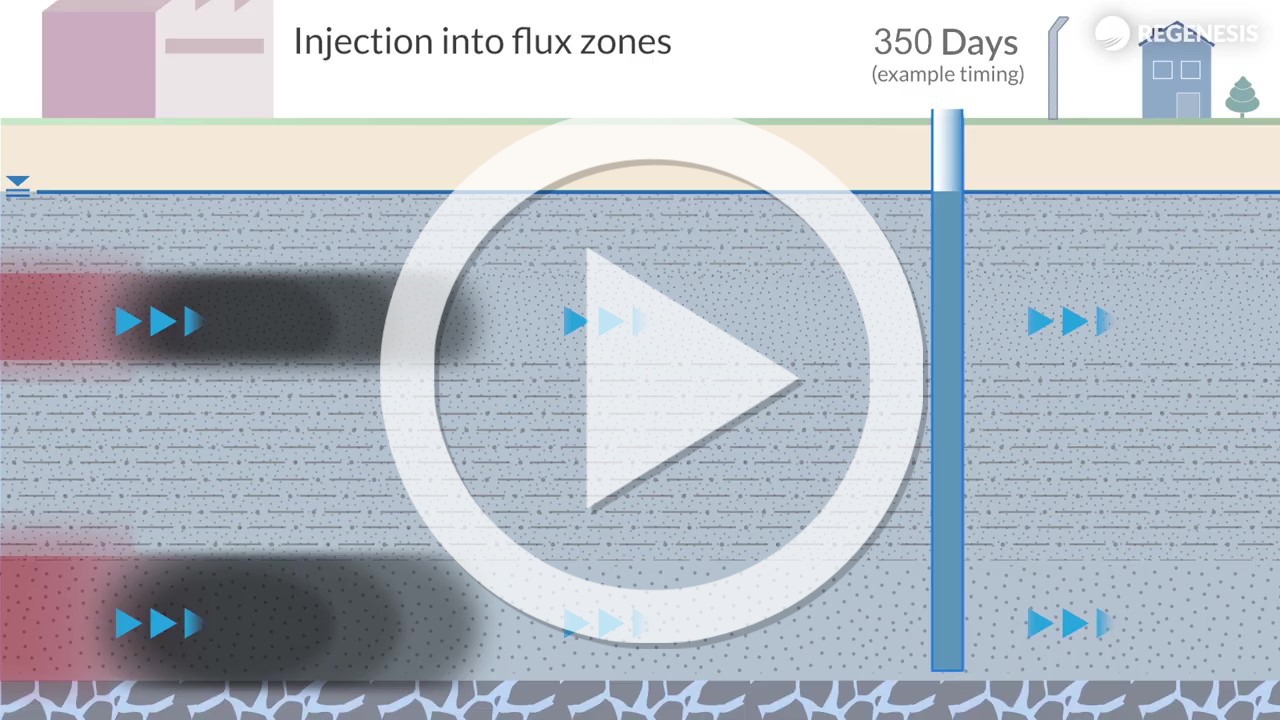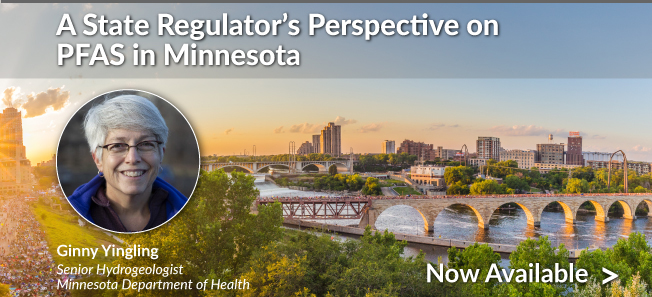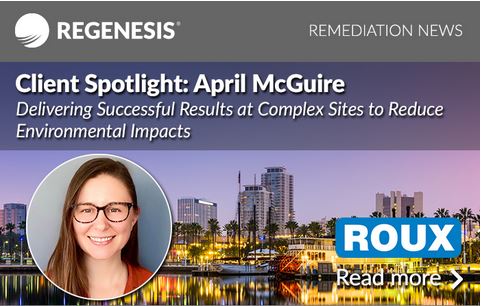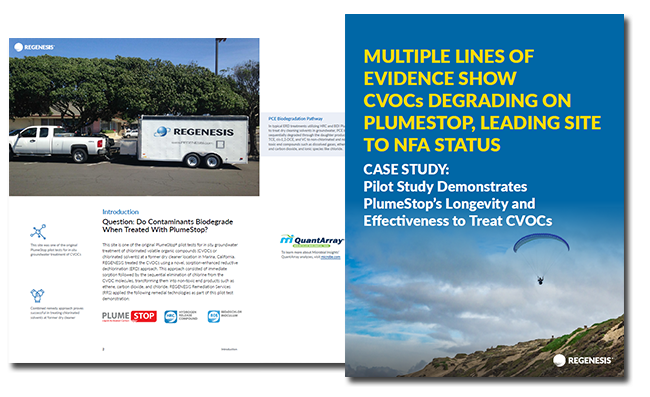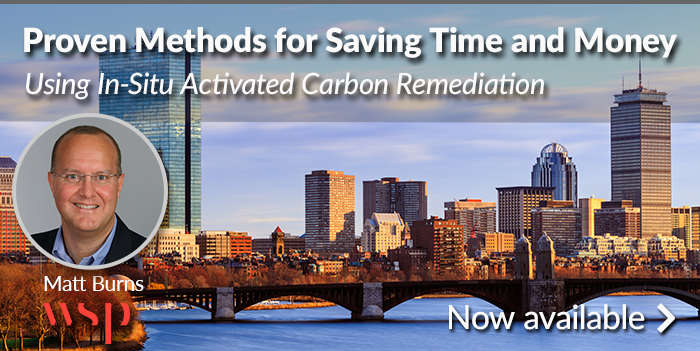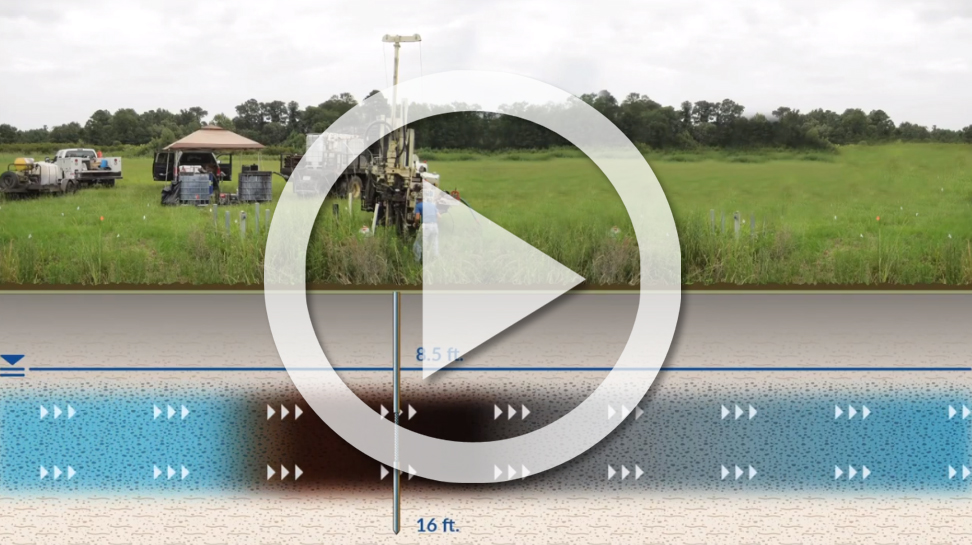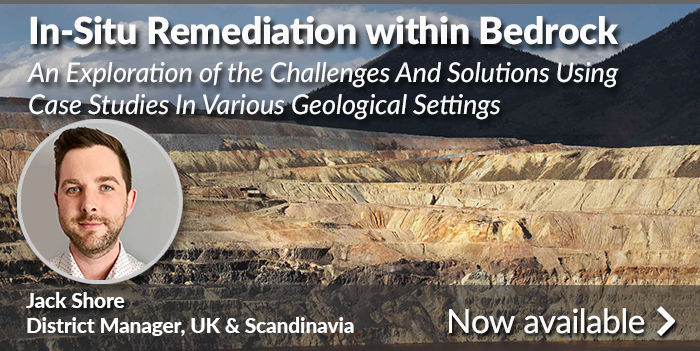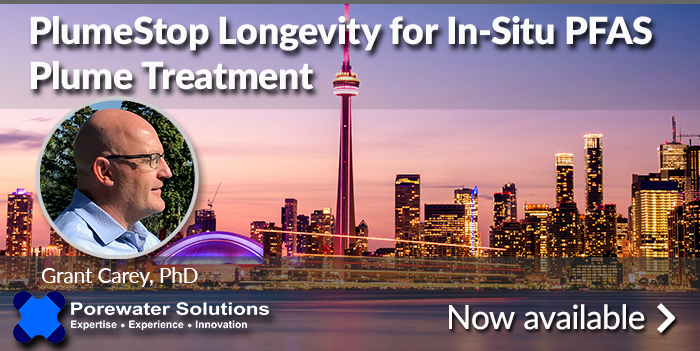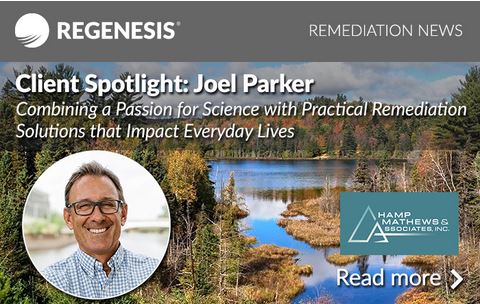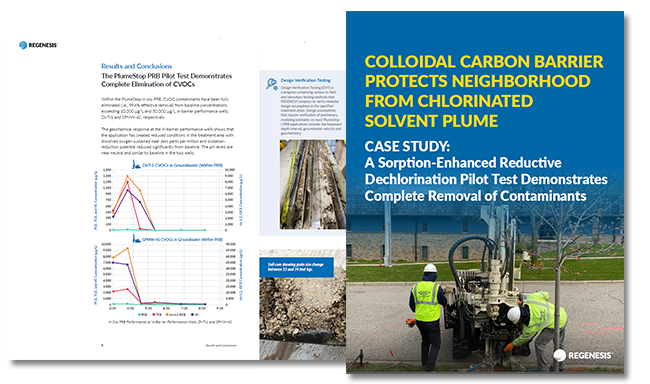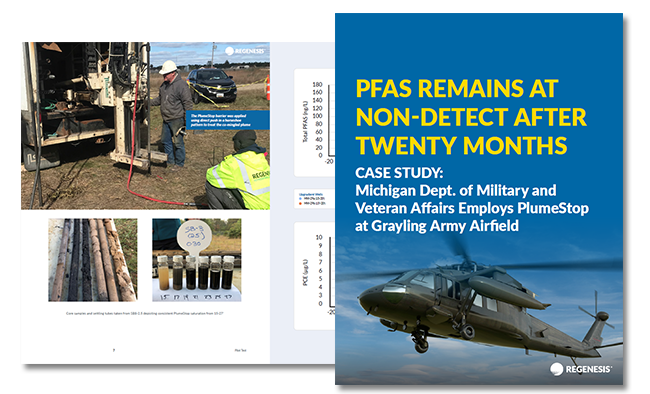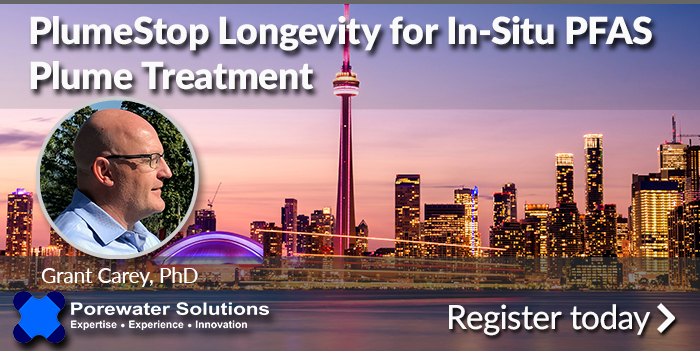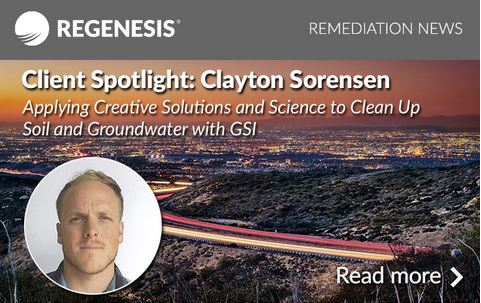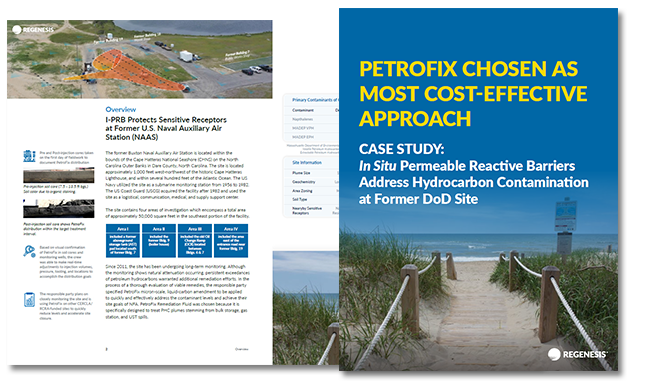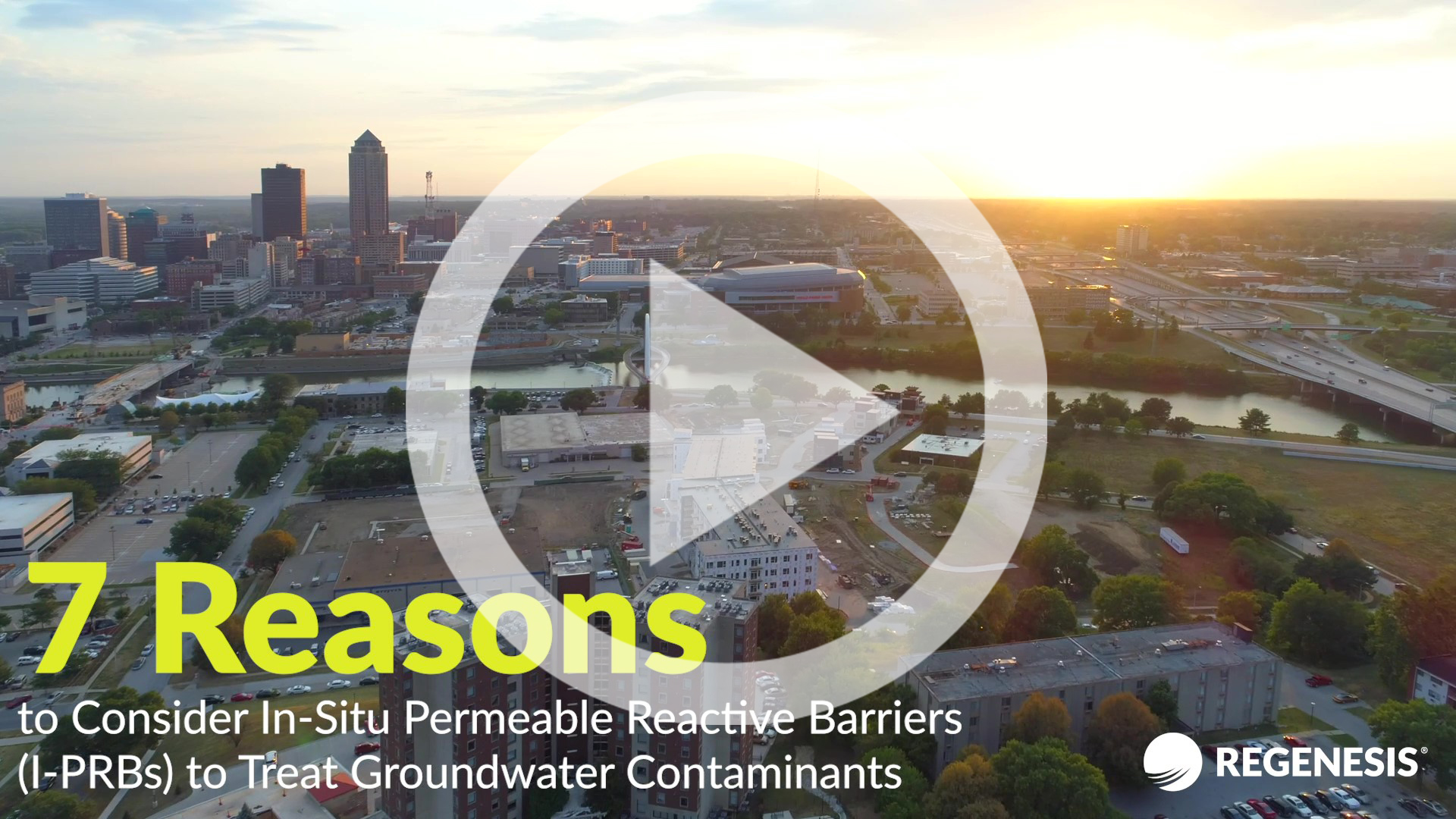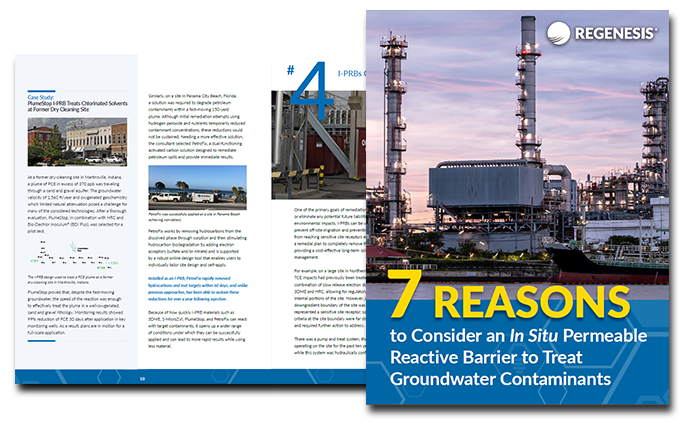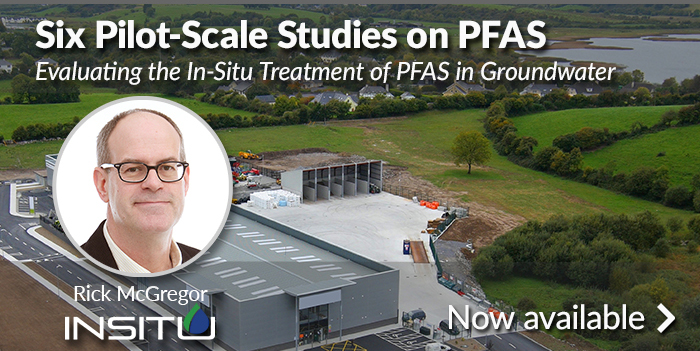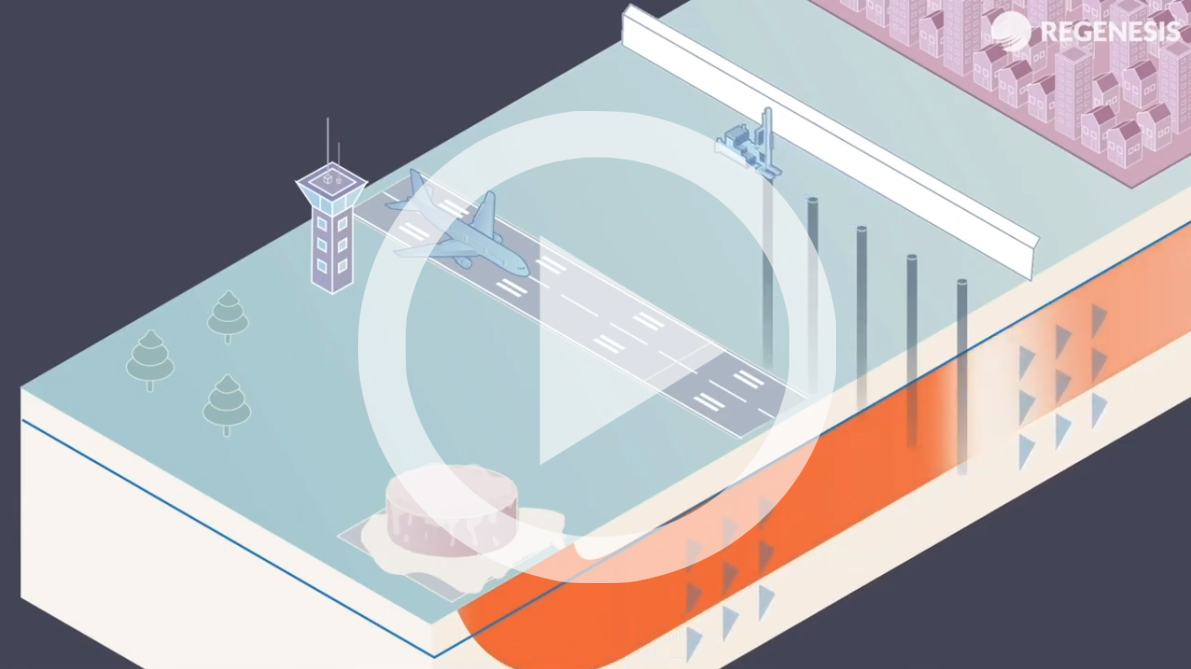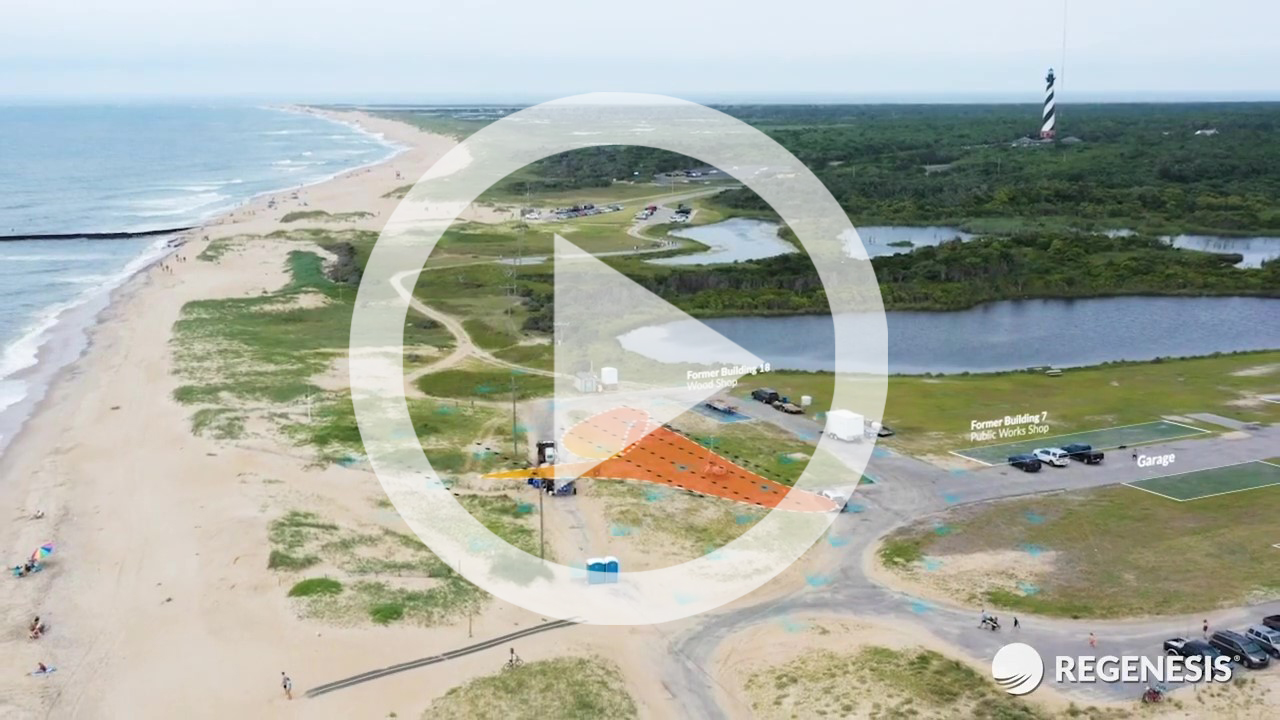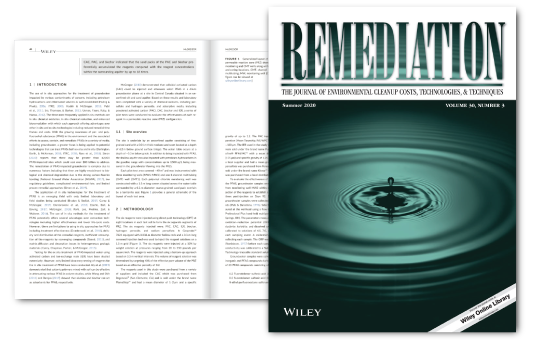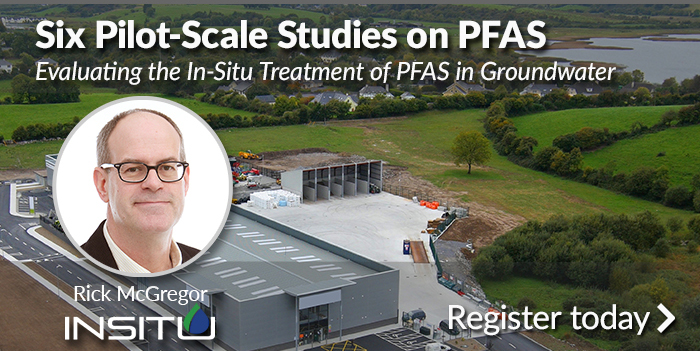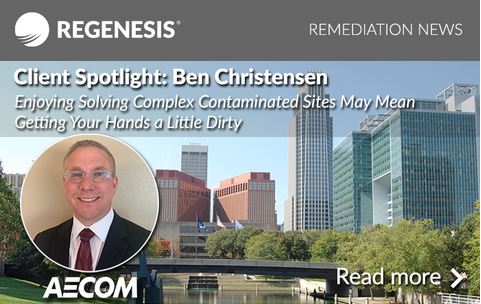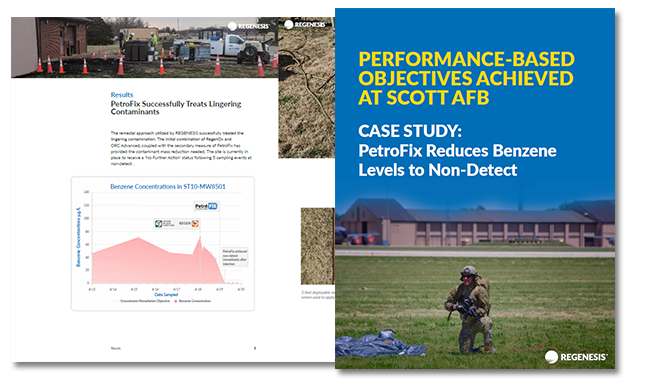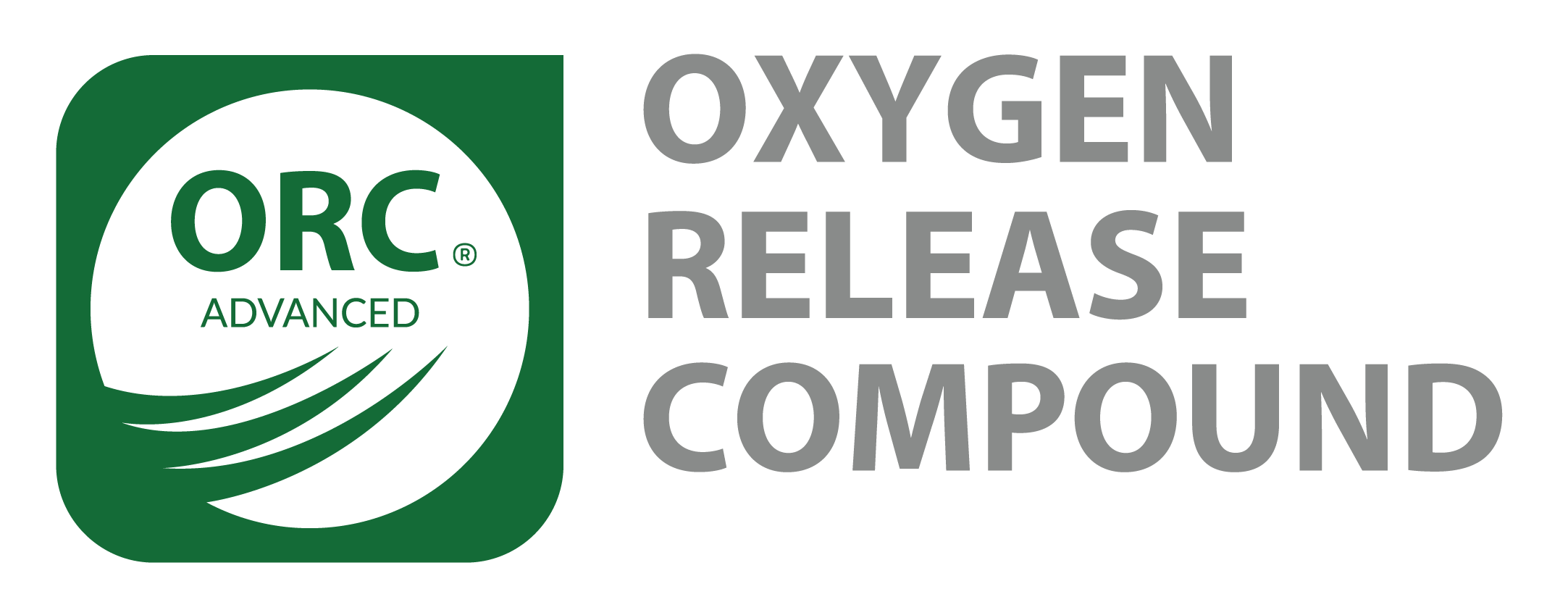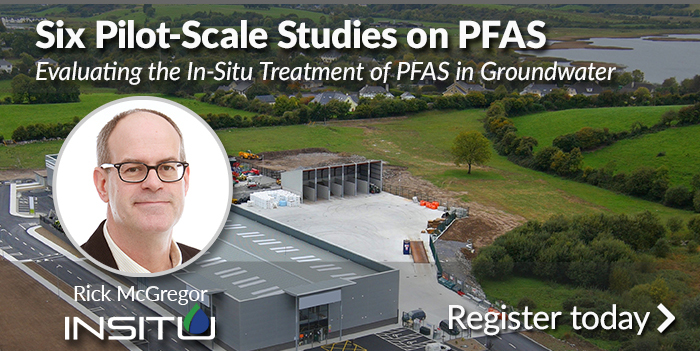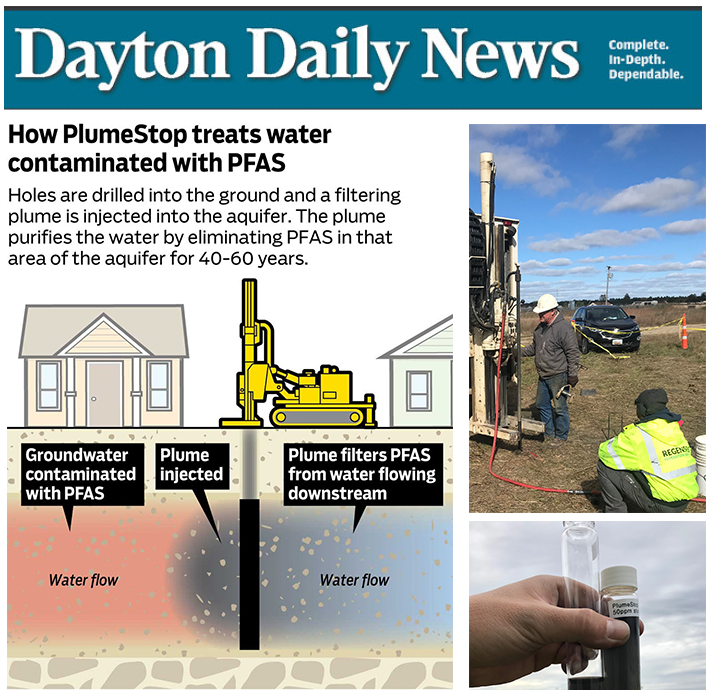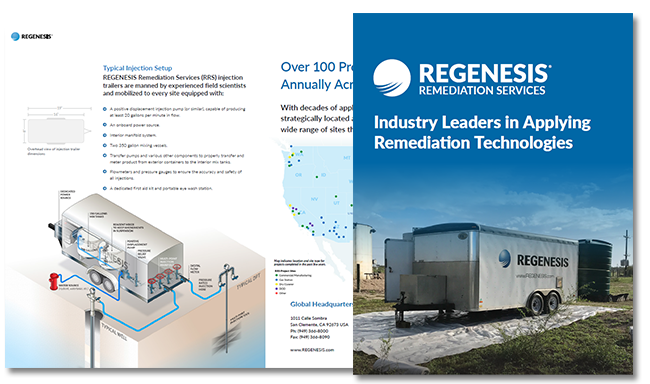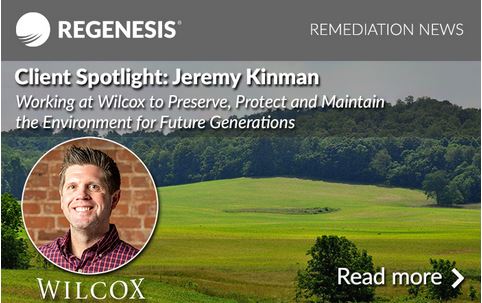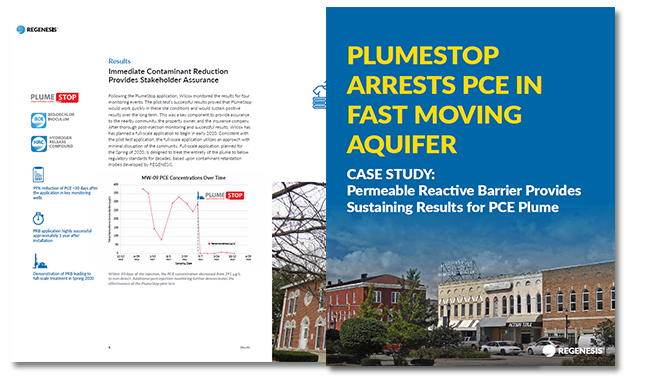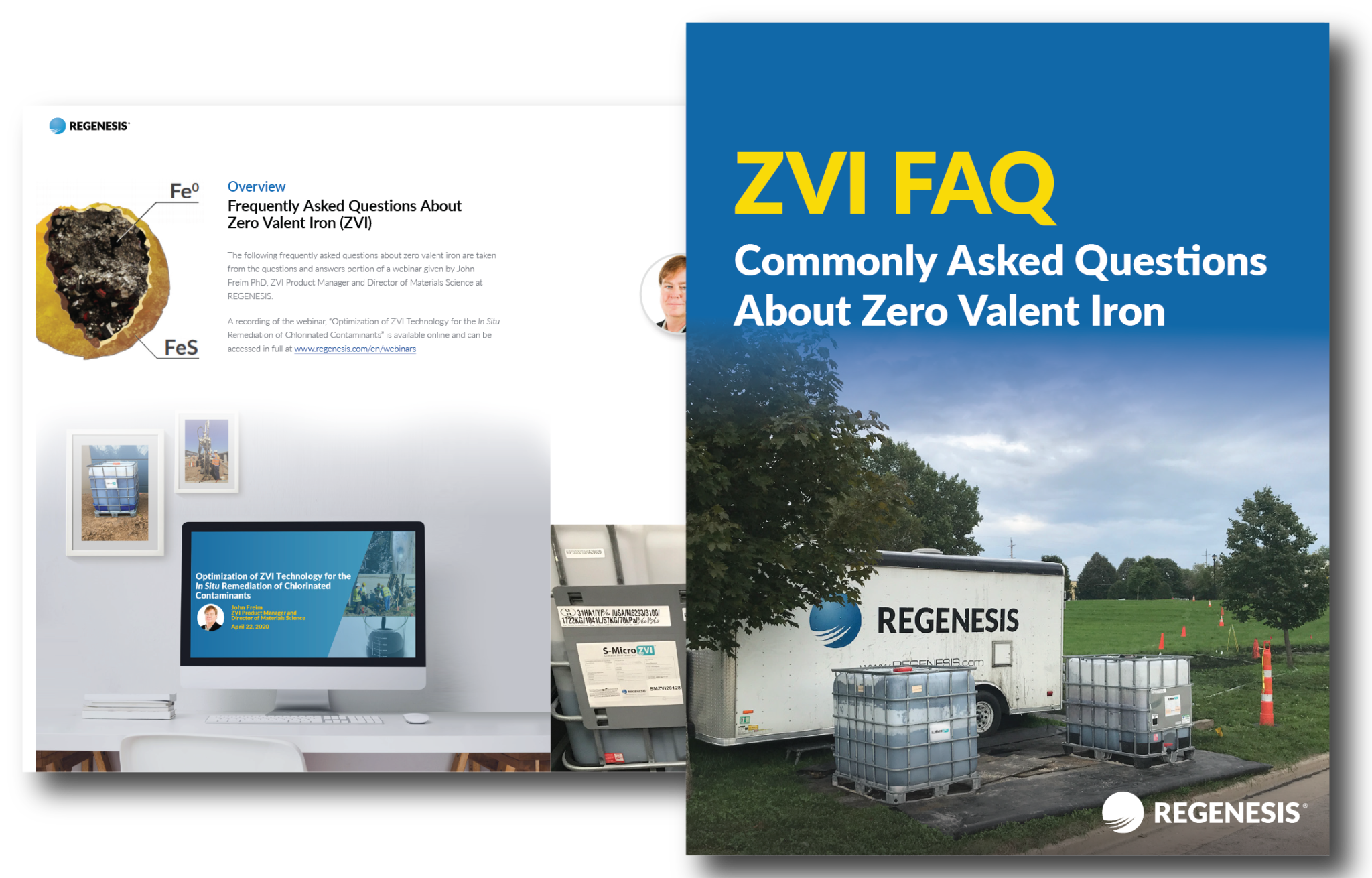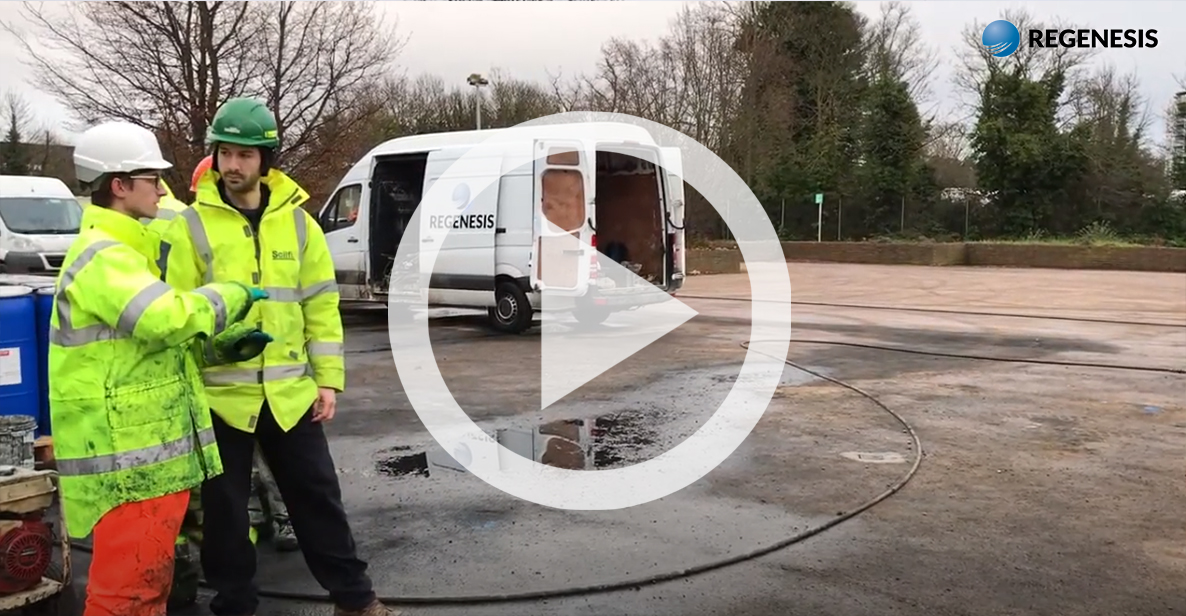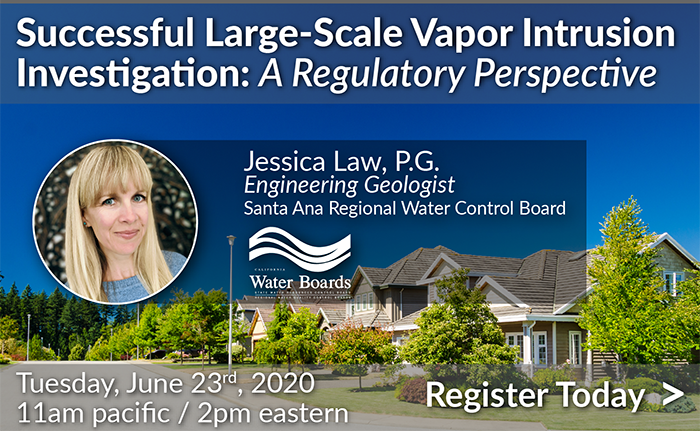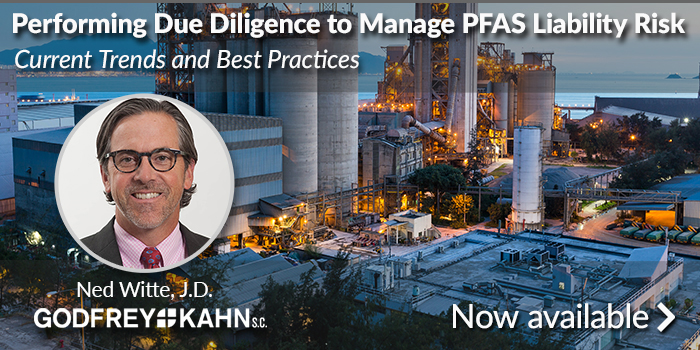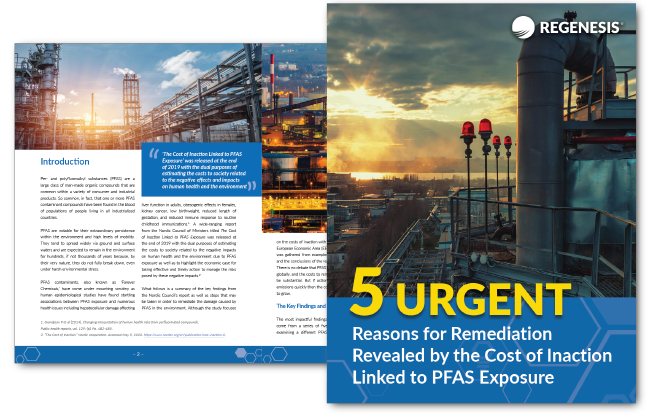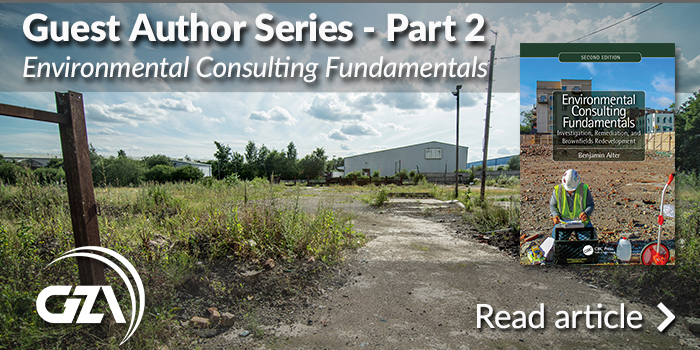March 2021 Newsletter
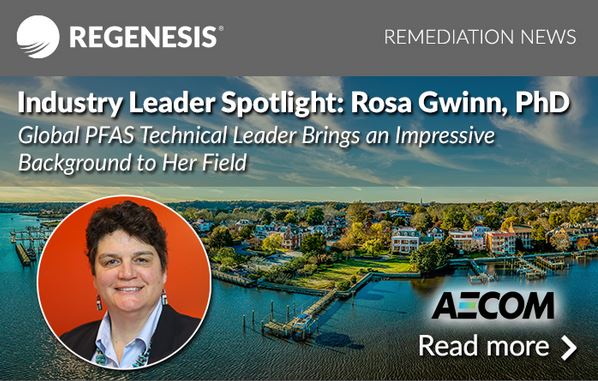
Client Spotlight: Rosa Gwinn, PhD
By combining academics with her professional environmental remediation experience, Rosa Gwinn, PhD, Global PFAS Technical Leader with AECOM, brings an impressive background to her field. She shares, “In my current role, I am responsible for sharing our PFAS thought leadership, ensuring the technical execution of PFAS work, collaborating internally and externally on solutions, and developing a best-in-class performance on PFAS-related projects. However, I also enjoy providing opportunities to promising and capable employees who are not as far along in their careers as I am.” Learn more in our client spotlight.
Subscribe To Our Monthly Newsletters
Webinar on PFAS Regulations and a Low-Cost Solution to Eliminate Risk via In-Situ Treatment
Cost-Effective Treatment to Eliminate the Risk from PFAS from REGENESIS in the News
Colloidal Activated Carbon Demonstrates Effective, In-Place Removal of PFAS from Groundwater
This article published in Technology Networks discusses a novel, colloidal form of activated carbon that demonstrates effective, in-place removal of PFAS from groundwater. Written by Kristen Thoreson, PhD, Vice President of Research and Development at REGENESIS, it discusses why PFAS in groundwater is a daunting environmental challenge, current methods for PFAS removal from groundwater, and a novel PFAS groundwater treatment technology that is effective and lower cost than other current methods: colloidal activated carbon passive barriers.
Eliminate the Risk of PFAS with Colloidal Activated Carbon
In situ remediation with colloidal activated carbon eliminates risk of PFAS contamination in soil and groundwater at a low-cost. By coating flux zones of an aquifer with colloidal activated carbon, a permeable sorption barrier is created in situ, purifying groundwater as it passively migrates. PFAS constituents from up-gradient source zones are rapidly sorbed to the carbon and removed from the mobile dissolved phase. By removing PFAS from the mobile phase, the route of exposure to down-gradient receptors is eliminated, thereby eliminating the down-gradient public health risk associated with PFAS.
Webinar on Effective Use of Colloidal Sulfidated ZVI and Activated Carbon in Permeable Reactive Barriers
In this webinar we were pleased to have a special presentation from three leading technical experts in the remediation industry – John Freim PhD, Ryan Moore CHMM, and Andrew Kavanagh of REGENESIS. This panel discussed using a synergistic mixture of colloidal sulfidated ZVI and activated carbon to promote the enhanced performance of in situ reactive barriers. The recording of this webinar is now available.
Stay Up-to-date on Industry Technologies With Our Remediation Training Library
Questions?
REGENESIS has remediation experts based worldwide to assist you in your brownfield site cleanup. As the technology leader in advanced bioremediation solutions, we can help ensure success on your next remediation project. Use the map on our website to find your regional REGENESIS contact today.
February 2021 Newsletter
Client Spotlight: Tracey Mulhern
Ask Tracey Mulhern, Associate Geologist with Farallon Consulting, what she likes most about her work and you’ll likely learn that providing superior client service is just one of the many aspects she enjoys. She begins, “I enjoy working with clients to come up with environmental solutions to meet their individual needs. I also enjoy the planning that goes into a site investigation or cleanup and seeing it completed.” Currently, Mulhern conducts project management of contaminated site investigation and cleanup at various sites throughout Washington. Learn more about Tracey’s work at Farallon in our client spotlight.
Subscribe To Our Monthly Newsletters
PlumeStop Eliminates Offsite TCE Migration Meeting Site Goals in 60 Days
This case study reviews the site of a large-scale in situ groundwater treatment of trichloroethene (TCE) at a former industrial manufacturing facility in the Midwest that quickly achieved and then sustained performance objectives. TCE and low concentrations of other chlorinated volatile organic compounds (CVOCs), cis-1,2-dichloroethene, vinyl chloride, and 1,1,1-trichloroethane, were treated using an innovative sorption-enhanced reductive dechlorination (ERD) approach virtually eliminating contaminants by the first monitoring event within 60 days of application. A permeable reactive barrier (PRB), installed at the site property boundary, has maintained 100 percent reduction in TCE for over three years, meeting the application’s performance objectives by cutting off the site’s contribution to a more extensive groundwater TCE plume.
Turn Polluted Aquifers into Purifying Filters with PlumeStop
Low-cost Bioremediation of Chlorinated Solvents
HRC is an engineered, hydrogen release compound designed specifically for enhanced, in situ anaerobic bioremediation of chlorinated compounds in groundwater or highly saturated soils. HRC enables enhanced anaerobic biodegradation by adding hydrogen (an electron donor) to groundwater and/or soil to increase the number and vitality of indigenous microorganisms able to perform the naturally occurring process of enhanced reductive dechlorination. Due to its capability of being applied via permanent wells, direct-push, and excavations, this reagent allows for clean, low-cost, non-disruptive application.
Accelerated Treatment of Intermediate Compounds
BDI Plus is designed to provide rapid, effective treatment of undesirable anaerobic dechlorination intermediate compounds such as dichloroethene (DCE) and vinyl chloride (VC), and is a low-cost means of enhancing the anaerobic biodegradation process. Once in place, this microbial consortium accelerates the rate of chlorinated contaminant degradation from parent compounds to intermediates like DCE and VC and completely through to harmless end products such as ethene and ethane. It is highly compatible with a range of electron donors.
Over 8 Million Cubic Feet of Groundwater Treated In 13 Days
This case study reviews the site of a large-scale enhanced reductive dechlorination (ERD) treatment of chlorinated volatile organic compounds (CVOCs) applied in a fractured bedrock aquifer at a voluntary remediation site in Pennsylvania. REGENESIS Remediation Services (RRS) began the application in May 2020 and completed it in less than 13 days, averaging nearly 7,000 gallons of fluid volume injected per day at this active facility. In total, more than 260,000 combined pounds of 3DME, CRS and BDI Plus were injected for ERD treatment of the CVOCs. The extensive injection well network and large injection volume required RRS to develop an innovative injection process and containment design.
Long-Term, Low-Cost Remediation of Chlorinated Solvents
A Liquid Iron Based-Reagent for the Enhanced In Situ Chemical Reduction (ISCR) of Chlorinated Contaminants
CRS (Chemical Reducing Solution) is an iron-based amendment for in situ chemical reduction (ISCR) of halogenated hydrocarbon contaminants such as chlorinated ethenes and ethanes. This highly efficient in situ remediation technology contains a form of liquid iron which provides better distribution than can be achieved by directly injecting a solid iron material into the subsurface. The product allows for seamless integration with anaerobic bioremediation, and is easy to apply with the electron donor 3-D Microemulsion.
Video Shows How PetroFix is Easily and Safely Applied to Effectively Treat Petroleum Contaminants
Questions?
REGENESIS has remediation experts based worldwide to assist you in your brownfield site cleanup. As the technology leader in advanced bioremediation solutions, we can help ensure success on your next remediation project. Use the map on our website to find your regional REGENESIS contact today.
January 2021 Newsletter
Client Spotlight: Emma McAnaw
Emma McAnaw is a Senior Hydrogeologist and experienced Project Manager at Golder, a global consulting and engineering firm. Emma’s international experience spans the manufacturing, waste, mining, power and infrastructure sectors. Based out of the UK, working at Golder has taken her to sites all over the UK, as well as Colombia, Bulgaria, Greece, and Gibraltar. As Project Manager, Emma enjoys seeing all the moving parts of a project coming together. At the same time, she also still likes being “hands-on” with the site investigation and remediation work which comes with managing junior staff. Learn more in our client spotlight.
Subscribe To Our Monthly Newsletters
PlumeStop Effectively Treats Chlorinated Solvents in Bedrock at UK Site
This case study reviews the site of a chlorinated solvent spill where REGENESIS was asked to provide a remediation solution for a Trichloroethylene (TCE) plume in the UK. The technical services team at REGENESIS worked closely with Golder to design and implement a novel solution that combined Plumestop, HRC and BDI+ to sorb and biologically degrade the contamination, rapidly and effectively reducing contamination downstream to nondetectable levels. The PlumeStop in situ permeable reactive barrier rapidly reduced downgradient contaminant concentrations and maintained these through a combination of sorption and biological degradation, protecting the adjacent surface water receptor.
Turn Polluted Aquifers into Purifying Filters with PlumeStop
Low-cost Bioremediation of Chlorinated Solvents
HRC is an engineered, hydrogen release compound designed specifically for enhanced, in situ anaerobic bioremediation of chlorinated compounds in groundwater or highly saturated soils. HRC enables enhanced anaerobic biodegradation by adding hydrogen (an electron donor) to groundwater and/or soil to increase the number and vitality of indigenous microorganisms able to perform the naturally occurring process of enhanced reductive dechlorination. Due to its capability of being applied via permanent wells, direct-push, and excavations, this reagent allows for clean, low-cost, non-disruptive application.
Accelerated Treatment of Intermediate Compounds
BDI Plus is designed to provide rapid, effective treatment of undesirable anaerobic dechlorination intermediate compounds such as dichloroethene (DCE) and vinyl chloride (VC), and is a low-cost means of enhancing the anaerobic biodegradation process. Once in place, this microbial consortium accelerates the rate of chlorinated contaminant degradation from parent compounds to intermediates like DCE and VC and completely through to harmless end products such as ethene and ethane. It is highly compatible with a range of electron donors.
Successful Pilot Study On Former Bulk Storage Site
This case study reviews a full-scale PetroFix remediation program that was designed and implemented at seven locations to treat petroleum hydrocarbons (PHCs) following a successful field pilot test. Two post-injection groundwater sampling events were completed in June and September 2019. In December 2019, a supplemental PetroFix injection was completed in the PHC source area onsite following the PersulfOx and ORC-A pretreatment step and groundwater equilibration. Working with REGENESIS, the environmental consulting firm Patriot Engineering developed a site closure strategy that included reducing groundwater concentrations, inhibiting plume migration, and demonstrating plume stability site-wide.
Apply Activated Carbon Under Low Pressure to Treat Petroleum Hydrocarbons
Questions?
REGENESIS has remediation experts based worldwide to assist you in your brownfield site cleanup. As the technology leader in advanced bioremediation solutions, we can help ensure success on your next remediation project. Use the map on our website to find your regional REGENESIS contact today.
December 2020 Newsletter
Client Spotlight: Arun Wahi
Arun Wahi, Senior Hydrogeologist with INTERA Inc., a leading international geosciences and engineering consulting firm, specializes in contaminant fate and transport analyses of organic and inorganic contaminants and radionuclides, including numerical models of vadose zone and groundwater flow and transport. He shares, “I enjoy the challenges associated with mathematics and learning new chemistry of emerging contaminants or forensic techniques, but the most rewarding part of my job is influencing concrete actions that protect human health and the environment.” Learn more in our client spotlight.
Subscribe To Our Monthly Newsletters
Combined Remedy Reduces Chlorinated Solvents to Achieve Closure Status with Florida DEP
This case study reviews the site of a chlorinated solvent spill as part of former dry cleaner operations at a retail shopping center in St. Petersburg, Florida. AECOM®, a global environmental consulting firm, was engaged to develop a solution for the site. The application called for an in situ groundwater treatment of low-concentration chlorinated volatile organic compounds (CVOCs). AECOM enlisted REGENESIS to design and implement an innovative sorption-enhanced reductive dechlorination (ERD) bioremediation approach for treating the CVOC contaminants. The results of the effort led to the Florida Department of Environmental Protection issuing a Site Rehabilitation Completion Order, releasing the property owner from further obligation to conduct remediation at the project site (i.e., site regulatory closure).
Turn Polluted Aquifers into Purifying Filters with PlumeStop
Low-cost Bioremediation of Chlorinated Solvents
HRC is an engineered, hydrogen release compound designed specifically for enhanced, in situ anaerobic bioremediation of chlorinated compounds in groundwater or highly saturated soils. HRC enables enhanced anaerobic biodegradation by adding hydrogen (an electron donor) to groundwater and/or soil to increase the number and vitality of indigenous microorganisms able to perform the naturally occurring process of enhanced reductive dechlorination. Due to its capability of being applied via permanent wells, direct-push, and excavations, this reagent allows for clean, low-cost, non-disruptive application.
Remediation of Chlorinated Solvents with PlumeStop Liquid Activated Carbon
PlumeStop technology can be applied to inhibit spreading of contaminant plumes, to protect sensitive receptors, or to prevent contaminant migration across property boundaries. It is also an effective tool for control and treatment of groundwater contamination associated with low-permeability porous formations and matrix back-diffusion, promoting diffusion out of the immobile porosity while preventing groundwater impact, and for treating sites with very low contaminant concentrations. Once in place, PlumeStop is expected to last for decades with minimal impact on aquifer oxidation-reduction potential, permeability and geochemistry.
Webinar Now Available: A State Regulator’s Perspective on PFAS in Minnesota
In this webinar we were pleased to have as a special guest speaker Ginny Yingling, Senior Hydrogeologist at Minnesota Department of Health. Her presentation shared a state regulator’s perspective on PFAS in Minnesota. She was joined by Scott Wilson, President & CEO at REGENESIS, who discussed the extent to which colloidal activated carbon has been accepted by the remediation industry as a low-cost method of eliminating PFAS risk.
Questions?
REGENESIS has remediation experts based worldwide to assist you in your brownfield site cleanup. As the technology leader in advanced bioremediation solutions, we can help ensure success on your next remediation project. Use the map on our website to find your regional REGENESIS contact today.
November 2020 Newsletter
Client Spotlight: April McGuire
By working with various teams to design and complete projects that help reduce a development’s impact on the environment, and by producing results that exceed client expectations, April McGuire, Project Engineer for Roux receives a “double dose” of satisfaction from her work. She shares, “Working with other intelligent and passionate people in the Roux Long Beach office on complex sites, delivering on projects, and making clients happy is what it’s all about.” In her current role, she manages various types of projects, including remediation, site investigations, and vapor intrusion mitigation system designs.
Subscribe To Our Monthly Newsletters
PlumeStop Effectively Degrades Contaminants to Lead Northern California Site to NFA Status
This case study reviews one of the original PlumeStop® pilot tests for in-situ groundwater treatment of chlorinated volatile organic compounds (CVOCs or chlorinated solvents) at a former dry cleaner location in Marina, California. REGENESIS treated the CVOCs using a novel, sorption-enhanced reductive dechlorination (ERD) approach. This approach consisted of immediate sorption followed by the sequential elimination of chlorine from the CVOC molecules, transforming them into non-toxic end products such as ethene, carbon dioxide, and chloride.
Turn Polluted Aquifers into Purifying Filters with PlumeStop
Webinar Now Available: Matt Burns Showcasing Proven Methods for Saving Time and Money
In this webinar we were pleased to have as a special guest speaker Matt Burns, Technical Director of Environmental Services for WSP. His presentation discussed proven methods for saving time and money using in-situ activated carbon remediation. He was joined by Maureen Dooley, Director of Strategic Projects at REGENESIS
Petroleum Hydrocarbons Treated with PetroFix at Former Naval Auxiliary Air Station, Edenton Site is the 3rd NAAS Site Successfully Treated with PetroFix
This video showcases the former Naval Auxiliary Air Station, Edenton, the third Naval Auxiliary Air Station site successfully treated with PetroFix. In order to quickly close the site, the responsible party has chosen PetroFix to reduce contaminants to below North Carolina groundwater quality standards. The micron-scale liquid carbon amendment was chosen because it was the most cost-effective, easy-to-apply solution to treat the petroleum hydrocarbons in groundwater.
Apply Activated Carbon Under Low Pressure to Treat Petroleum Hydrocarbons
PetroFix is an activated carbon remediation technology that is easily injected in situ under low pressure, distributes in the subsurface without fracturing, and includes electron acceptors to stimulate biodegradation of petroleum contaminants in soil and groundwater. This cost-effective technology is designed to remediate petroleum spills and provide immediate results for gas station and UST sites. It works with the PetroFix Design Assistant™, an online design tool that enables users to individually tailor their site designs and self-apply PetroFix.
Newly Released Webinar Provides Guidance for In-Situ Remediation at Fractured Bedrock Sites
This webinar covers the challenges of the treatment within bedrock aquifers and discusses appropriate resources to help with the design of site investigations for fractured bedrock sites, enabling the deployment of robust in-situ remediation strategies. Jack Shore, UK and Scandinavia District Manager for REGENESIS, explains how a range of technologies can be used to overcome these challenges; focusing on in-situ anaerobic and aerobic biological degradation, sorption using micron-scale colloidal activated carbon, enhanced desorption coupled with vacuum extraction and in-situ chemical oxidation.
Webinar with PFAS Industry Expert, Dr. Grant Carey Presenting on PlumeStop Longevity
In this webinar we were pleased to have as a special guest speaker Grant Carey, Ph.D., President of Porewater Solutions. His presentation discussed PlumeStop longevity for in-situ PFAS plume treatment. He was joined by Ryan Moore, PFAS Program Manager at REGENESIS, who discussed in-situ treatment of PFAS using colloidal activated carbon to eliminate PFAS risk at a low cost.
Questions?
REGENESIS has remediation experts based worldwide to assist you in your brownfield site cleanup. As the technology leader in advanced bioremediation solutions, we can help ensure success on your next remediation project. Use the map on our website to find your regional REGENESIS contact today.
October 2020 Newsletter
Client Spotlight: Joel Parker
For Joel Parker, Principal Engineer with Hamp, Mathews & Associates, a Michigan-based environmental remediation firm, the opportunity to combine his passion for science with practical remediation solutions that impact our everyday lives provides the ideal footing for offering clients sound technical advice that can lead to optimal remediation outcomes. He begins, “My favorite aspect of my position is living at the fringes of all the sciences. I function at a nexus of physics, chemistry, biology, geology and hydrogeology. It is very rewarding to ‘play’ in a space where those sciences mix in the real world.” Learn more in our client spotlight.
Subscribe To Our Monthly Newsletters
Colloidal Carbon Barrier Protects Neighborhood from Chlorinated Solvent Plume
This case study reviews a field-scale pilot test using REGENESIS technologies for in situ groundwater treatment of chlorinated volatile organic compounds (CVOCs) at high concentrations, in a fast-moving, aerobic aquifer beneath a residential neighborhood. The CVOCs were treated using a unique combination of remediation technologies, symbiotically promoting sorption-enhanced reductive dechlorination (ERD) via biotic and abiotic processes. Hamp, Mathews & Associates, Inc., a leading environmental consultant, enlisted REGENESIS to design and install an in situ permeable reactive barrier (PRB) to fully treat the tetrachloroethene (PCE), trichloroethene (TCE), cis-1,2-DCE (cis-DCE), and vinyl chloride, converting them into nontoxic end products such as ethene, ethane, carbon dioxide, and chloride.
Turn Polluted Aquifers into Purifying Filters with PlumeStop
ZVI Optimized for Reactivity and Superior Distribution
REGENESIS offers S-MicroZVI, an advanced zero-valent iron (ZVI) product proven to accomplish In Situ Chemical Reduction (ISCR) of contaminants within the subsurface environment. S-MicroZVI is delivered as a colloidal suspension 40% ZVI by weight in glycerol with a particle size of less than 5 microns. S-MicroZVI is manufactured using a state-of-the-art sulfidation process resulting in a particle coating which increases activation toward specific contaminants and extends performance longevity. S-MicroZVI destroys contaminants abiotically and applied to stimulate ISCR-enhanced bioremediation.
PFAS Remains at Non-Detect After 20 Months Following Application of PlumeStop at DoD Site
This updated case study reviews a pilot test to remove PFAS risk via an in situ colloidal activated carbon barrier at Camp Grayling in Crawford County, Michigan, a large year-round military training center operated by the Michigan Army National Guard (MIARNG). Colloidal activated carbon was selected because of the expected rapid reductions of PFAS by removal from the dissolved mobile phase, as well as its expected lower total project costs when compared to operating a mechanical system over a similar time. Download the case study to learn how the colloidal activated carbon permeable reactive barrier treated PFAS to non-detect.
Upcoming Webinar with Matt Burns Showcasing Proven Methods for Saving Time and Money
In this webinar we are pleased to have as a special guest speaker Matt Burns, Technical Fellow and the U.S. Contaminated Land National Service Line Director for WSP. His presentation will discuss proven methods for saving time and money using in-situ activated carbon remediation. He will be joined by Maureen Dooley, Director of Strategic Projects at REGENESIS. This live webinar starts Thursday, October 29th, 2019 at 11am pacific/2pm eastern.
Upcoming Webinar with PFAS Industry Expert, Dr. Grant Carey Presenting on PlumeStop Longevity
In this webinar we are pleased to have as a special guest speaker Grant Carey, Ph.D., President of Porewater Solutions. His presentation will discuss PlumeStop longevity for in-situ PFAS plume treatment. He will be joined by Maureen Dooley, Director of Strategic Projects at REGENESIS, who will discuss in-situ treatment of PFAS using colloidal activated carbon to eliminate PFAS risk at a low cost. This live webinar starts Thursday, November 19th, 2020 at 11am pacific/2pm eastern.
Questions?
REGENESIS has remediation experts based worldwide to assist you in your brownfield site cleanup. As the technology leader in advanced bioremediation solutions, we can help ensure success on your next remediation project. Use the map on our website to find your regional REGENESIS contact today.
September 2020 Newsletter
Client Spotlight: Clayton Sorensen
Clayton Sorensen, Project Geologist with GSI Environmental Inc. (GSI), shares, “I chose a career in environmental remediation because I enjoy applying creative solutions and science to complex problems.” In his current role with GSI, Sorensen works to assess and clean up soil and groundwater on a variety of sites. He continues, “I manage field implementation for investigation and remediation of various constituents in soil and groundwater including PFAS, chlorinated solvents and heavy metals, both in fractured and porous media.”
Subscribe To Our Monthly Newsletters
PetroFix Chosen as Most Cost-Effective Option to Address Petroleum Contaminants at DoD Site
This case study reviews a PetroFix application to address hydrocarbon contaminants at the former Buxton Naval Auxiliary Air Station, located within the Cape Hatteras National Park in the Outerbanks region of North Carolina. The US Navy utilized the site as a submarine monitoring station from 1956 to 1982. The US Coast Guard (USCG) acquired the facility after 1982 and used the site as a logistical, communication, medical, and supply support center. The site contains four areas of investigation which encompass a total area of approximately 50,000 square feet. PetroFix Remediation Fluid was chosen because it is specifically designed to treat PHC plumes stemming from bulk storage, gas station, and UST spills.
Apply Activated Carbon Under Low Pressure to Treat Petroleum Hydrocarbons
7 Reasons to Consider an In-Situ Permeable Reactive Barrier to Treat Groundwater Contaminants
This video outlines 7 reasons to consider an in-situ permeable reactive barrier (I-PRB) to treat groundwater contaminants. If designed intelligently and installed correctly, I-PRBs can be a highly cost-effective and customizable remediation tool that environmental practitioners can use to achieve cleanup goals.
eBook Provides Analysis of Effectiveness of In-Situ Permeable Reactive Barriers
PFAS Webinar Now Available!
In this webinar we were pleased to have as a special guest speaker Rick McGregor, President of InSitu Remediation Services Ltd. His presentation discussed six pilot-scale studies evaluating the in situ treatment of PFAS in groundwater. He was joined by Maureen Dooley, Director of Strategic Projects at REGENESIS, who discussed in situ treatment of PFAS using colloidal activated carbon to eliminate PFAS risk at a low cost.
How Colloidal Activated Carbon Eliminates PFAS Risk and Liability at a Low Cost
PlumeStop colloidal activated carbon utilizes activated carbon finely milled to >2µm (the size of a red blood cell) and suspended in a colloidal fluid to be injected under low pressure into the subsurface. The carbon particles disperse and diffuse, and then adhere to the surface of soil particles, converting contaminated aquifers into purifying filters. The PFAS contamination present in the groundwater is tightly adsorbed onto the PlumeStop in the subsurface, removing it from the groundwater and eliminating the downgradient risk to the region.
Questions?
REGENESIS has remediation experts based worldwide to assist you in your brownfield site cleanup. As the technology leader in advanced bioremediation solutions, we can help ensure success on your next remediation project. Use the map on our website to find your regional REGENESIS contact today.
August 2020 Newsletter
Client Spotlight: John Butillo
As the Engineering Manager for Sovereign Consulting Inc., John Butillo is responsible for bioremediation field application, from initial engineering design with system/plant installations, to maintenance and troubleshooting. He shares, “My technical role focuses primarily on facility engineering, permitting, project design, construction and installation of soil/groundwater remediation and wastewater treatment systems, and waste minimization programs.” Butillo has served as the lead design and implementation project manager and lead engineer on more than 100 soil and groundwater remediation projects. Learn more in our client spotlight.
Subscribe To Our Monthly Newsletters
PetroFix Applied at Former Buxton Naval Auxiliary Air Station to Treat Hydrocarbon Contaminants
This video explains the in situ remediation of hydrocarbon contaminants using PetroFix Remedial Fluid at former Buxton Naval Auxiliary Air Station. Due to contaminant level exceedances, the responsible party elected to pursue additional remediation efforts beyond monitored natural attenuation. After thoroughly evaluating remedial options, they selected PetroFix micron-scale liquid carbon amendment to capture and biodegrade the petroleum contaminants. 6,000 pounds of PetroFix were applied using direct push injection at 86 points. In addition to its ability to distribute effectively through the subsurface and reach target treatment zones, PetroFix was selected because it was the most cost-effective and least disruptive remedial approach available for the site.
Apply Activated Carbon Under Low Pressure to Treat Petroleum Hydrocarbons
Third Party Research Article – Six Studies on the In Situ Treatment of PFAS in Groundwater
eBook Provides Analysis of Effectiveness of In-Situ Permeable Reactive Barriers
Upcoming PFAS Webinar – Sign Up Today!
In this webinar we are pleased to have as a special guest speaker Rick McGregor, President of InSitu Remediation Services Ltd. His presentation will discuss six pilot-scale studies evaluating the in situ treatment of PFAS in groundwater. This free webinar begins Wednesday, August 12th, 2020 at 11am pacific/2pm eastern.
Questions?
REGENESIS has remediation experts based worldwide to assist you in your brownfield site cleanup. As the technology leader in advanced bioremediation solutions, we can help ensure success on your next remediation project. Use the map on our website to find your regional REGENESIS contact today.
July 2020 Newsletter
Client Spotlight: Ben Christensen
For Ben Christensen, Project Manager/Professional Engineer with AECOM, pursuing a career which involved working outside and “getting my hands dirty” was a primary motivator. He shares, “I have completed multiple soil and groundwater investigations. I’ve also implemented groundwater and soil remediation by in situ chemical and bio-remediation injections, groundwater pump and treat systems, soil-vapor extraction (SVE) systems, bioventing, and excavation.” In his current role, he manages firm-fixed price projects at Nellis AFB, Offutt AFB, and Scott AFB, that include about 30 sites. Learn more in our client spotlight.
Subscribe To Our Monthly Newsletters
Performance-Based Objectives Achieved at Scott AFB
This case study reviews the Corrective Action Plan (CAP) at Scott Air Force Base, a large military base located in Southwestern Illinois that was contaminated with petroleum impacted soil. One month following the application of PetroFix®, contaminant levels reached non-detect. Benzene continued to remain non-detect through March 2020 and the site was recommended for no further action.
Apply Activated Carbon Under Low Pressure to Treat Petroleum Hydrocarbons
ISCO Solution Gets Sites to Closure Quickly
RegenOx® is an injectable, two-part ISCO reagent that combines a solid sodium percarbonate based alkaline oxidant (Part A), with a liquid mixture of sodium silicates, silica gel and ferrous sulfate (Part B), resulting in a powerful contaminant destroying technology. RegenOx directly oxidizes contaminants while its unique catalytic component generates a range of highly oxidizing free radicals that rapidly and effectively destroy a range of target contaminants including both petroleum hydrocarbons and chlorinated compounds.
Remediation Technology Tailored to the Petroleum Industry
ORC Advanced® is an engineered, oxygen release compound designed specifically for enhanced, in situ aerobic bioremediation of petroleum hydrocarbons in groundwater and saturated soils. ORC Advanced technology and applications have been tailored around the remediation needs of the retail petroleum industry, and have resulted in decreased time to site closure, and degradation rates accelerated up to 100 times faster than natural degradation rates.
Upcoming PFAS Webinar – Sign Up Today!
In this webinar we are pleased to have as a special guest speaker Rick McGregor, President of InSitu Remediation Services Ltd. His presentation will discuss six pilot-scale studies evaluating the in situ treatment of PFAS in groundwater. This free webinar begins Wednesday, August 12th, 2020 at 11am pacific/2pm eastern.
Featured Article – Cleaning up ‘forever’ chemicals in drinking water not easy task
PlumeStop, a colloidal activated carbon remediation technology from REGENESIS, was recently featured in the Dayton Daily News because of its ability to eliminate risk from PFAS contaminants in groundwater at a low cost compared to other currently available treatment methods. Because PFAS is a growing concern for communities trying to protect public health, PlumeStop is increasingly being applied to halt the spread of PFAS plumes and quickly remove risk. This article written by Ismail Turay Jr. is republished courtesy of the Dayton Daily News.
Upcoming Webinars – Register Today!
REGENESIS is pleased to announce our Summer and Fall 2020 Webinars. This series will feature three special guest presentations from distinguished professionals in the remediation industry. The topics of these webinars include innovative use of a preemptive vapor barrier, six pilot-scale studies evaluating the in situ treatment of PFAS in groundwater, and a case study in which an in situ strategy effectively treated PFAS at a Superfund site.
Vapor Intrusion Webinar Recording Now Available
In this webinar we are pleased to have a special presentation from Jessica Law, PG, Engineering Geologist and Case Manager for the Santa Ana Regional Water Quality Control Board. This presentation discussed a case study outlining the largest residential vapor intrusion investigation in California at the site of a former aerospace manufacturer. Joining Ms. Law is Thomas Szocinski, CEP, Land Science Director of Vapor Intrusion, who shared effective approaches to mitigating vapor intrusion on sites like the one discussed in the featured case study.
Industry Leaders in Applying Remediation Technologies
With decades of application experience, our Field Service Team is strategically located across the country to mobilize and assist on a wide range of sites throughout the US. REGENESIS Remediation Services (RRS) injection trailers are staffed by experienced field scientists and mobilized to every site equipped with a positive displacement injection pump (or similar), capable of producing at least 20 gallons per minute in flow. To learn more about the typical injection setup of the industry-leading RRS application team, download the brochure.
Questions?
REGENESIS has remediation experts based worldwide to assist you in your brownfield site cleanup. As the technology leader in advanced bioremediation solutions, we can help ensure success on your next remediation project. Use the map on our website to find your regional REGENESIS contact today.
June 2020 Newsletter
Client Spotlight: Jeremy Kinman
Jeremy Kinman is Associate Technical Director for Wilcox Environmental Engineering, Inc. Kinman realizes his work is indeed benefitting our planet, while also providing him with a role that is both rewarding and challenging. He shares, “One of the more rewarding aspects of my job is being in a position to assist a client with property redevelopment or obtaining an incident closure letter from the state regulatory agency.” At Wilcox, he started in the field and then transitioned into a project manager role and began designing work plans for investigation and remediation activities for projects he directly managed. Learn more in our client spotlight.
Subscribe To Our Monthly Newsletters
Performance-Based Objectives Achieved at Scott AFB
This case study reviews the Corrective Action Plan (CAP) at Scott Air Force Base, a large military base located in Southwestern Illinois that was contaminated with petroleum impacted soil. One month following the application of PetroFix®, contaminant levels reached non-detect. Benzene continued to remain non-detect through March 2020 and the site was recommended for no further action.
PlumeStop Arrests PCE in Fast Moving Aquifer
Turn Polluted Aquifers into Purifying Filters with PlumeStop
PlumeStop Liquid Activated Carbon is a break-through groundwater remediation technology that reduces dissolved phase contaminant plumes in days. Composed of extremely fine particles of activated carbon (1‐2μm) suspended in water through a proprietary dispersion chemistry, PlumeStop flows into the subsurface at low pressure and achieves consistent, reliable distribution – a capability unlike any other form of activated carbon used for groundwater remediation today.
Low-cost Bioremediation of Chlorinated Solvents
HRC is an engineered, hydrogen release compound designed specifically for enhanced, in situ anaerobic bioremediation of chlorinated compounds in groundwater or highly saturated soils. HRC enables enhanced anaerobic biodegradation by adding hydrogen (an electron donor) to groundwater and/or soil to increase the number and vitality of indigenous microorganisms able to perform the naturally occurring process of enhanced reductive dechlorination. Due to its capability of being applied via permanent wells, direct-push, and excavations, this reagent allows for clean, low-cost, non-disruptive application.
Accelerated Treatment of Intermediate Compounds
Bio-Dechlor INOCULUM Plus (BDI Plus) is designed to provide rapid and effective treatment of undesirable anaerobic dechlorination intermediates such as dichloroethene (DCE) and vinyl chloride (VC), and is a low-cost means of enhancing the anaerobic biodegradation process. Once in place, this microbial consortium accelerates the rate of chlorinated contaminant degradation from parent compounds to intermediates like DCE and VC and completely through to harmless end products such as ethene and ethane. It is highly compatible with a range of electron donors.
eBook: Zero-Valent Iron Frequently Asked Questions (FAQ)
The following frequently asked questions about zero-valent iron (ZVI) are taken from the questions and answers portion of a webinar given by John Freim PhD, ZVI Product Manager and Director of Materials Science at REGENESIS. Dr. Freim discussed the benefits of using zero valent iron as a powerful remediation amendment for the in situ remediation of chlorinated solvents. To learn about how ZVI works and the benefits of sulfidation, download the eBook.
Integrated Remediation of a Mixed Pesticides, TPH and VOC Plume at a Former Industrial Site in United Kingdom
This video explains the in situ remediation at a former industrial site of significant groundwater contamination: petroleum hydrocarbons, volatile organic compounds including BTEX, trimethylbenzene, and a mix of organochlorine pesticides, including pentachlorophenol, Lindane (gamma-HCH) and Dieldrin. An environmental solution consisting of multiple in situ remediation approaches was designed and implemented to meet the groundwater cleanup targets required as part of the property lease surrender process. Soilfix worked closely with REGENESIS on this challenging project. Great results were achieved within a tight time-scale on behalf of the FTSE100 company and their consultant Ramboll, resulting in successfully achieving the client’s project goals.
Upcoming Vapor Intrusion Webinar – Sign Up Today!
In this webinar we are pleased to have a special presentation from Jessica Law, PG, Engineering Geologist and Case Manager for the Santa Ana Regional Water Quality Control Board. This presentation will discuss a case study outlining the largest residential vapor intrusion investigation in California at the site of a former aerospace manufacturer. Joining Ms. Law will be Thomas Szocinski, CEP, Land Science Director of Vapor Intrusion, who will share effective approaches to mitigating vapor intrusion on sites like the one discussed in the featured case study. This free webinar begins Tuesday, June 23rd, 2020 at 11am pacific/2pm eastern.
PFAS Webinar Recording Now Available!
In this webinar we were pleased to have a special presentation from Ned Witte, Attorney at Godfrey & Kahn, S.C. Ned’s presentation discussed current trends and best practices for performing due diligence to manage PFAS liability risk. He will be joined by Ryan Moore, PFAS Program Manager at REGENESIS, who discussed proven, low-cost in situ remediation solutions to mitigate risk from PFAS contamination in groundwater. The recording of this webinar is available now.
NOTE: This webinar has been approved for Continuing Legal Education (CLE) by the Supreme Court of Ohio Commission on Continuing Legal Education.
A New Resource for Your End User Clients
This eBook outlines 5 reasons remediation of PFAS contaminated sites is vital to both human health and the global economy. Based on a wide-ranging report from the Nordic Council of Ministers entitled The Cost of Inaction Linked to PFAS Exposure, the report had the dual purposes of estimating the costs to society related to the negative impacts on human health and the environment due to PFAS exposure as well as to highlight the economic case for taking effective and timely action to manage the risks posed by these negative impacts. This eBook provides key takeaways from the report as well as highlighting cost-effective measures that communities can consider to treat PFAS liability and risk.
Guest Author Series – Part 2
REGENESIS is pleased to present an environmental article series from guest author, Benjamin Alter, leading environmental science author and Senior Vice President with GZA GeoEnvironmental, Inc. In this four-part series, Ben will provide an in-depth look at Brownfields. The second article is available now.
Questions?
REGENESIS has remediation experts based worldwide to assist you in your brownfield site cleanup. As the technology leader in advanced bioremediation solutions, we can help ensure success on your next remediation project. Use the map on our website to find your regional REGENESIS contact today.

